2012
Wiki This Part Two
05/12/12 18:06
As has been mentioned before, I really really love wikis. The collective information of many thousands of people with just enough extra time on their hands! Why, just today I was sending a link about the spanish word manzano (apple tree) to my little boy, and that link led me to a Wikipedia link to the Manzano mountains in New Mexico, where I used to live so I followed a link there to the Sandia mountains just north of the Manzanos and came to this picture:

(the giant version is much better) and, reading more about the mountains I loved to hike and bike in when I lived there, I find out this astonishing fact: it is an uplifted coral reef, probably!
And so the amount we can learn when we are all communicating is pretty fantastic. My students in GENE 3000H (Honors Evolution) just finished their website on the interface between climate change and evolutionary processes, and it is really impressive to me how much they accomplished. This started a conversation among the folks in my lab about things like Wikipedia - traditionally, the bane of professors grading undergraduate research papers - being considered a component of scientific outreach. So my student Christine posts this page on turtle barnacles, starting from scratch. Katie was updating the page on Unionid mussels today. We are thinking this will be part of our weekly lab group, when we catch up with what each of us have been doing we’ll discuss the topics we have added to, and learned from. Obviously, Wikipedia is generally only the starting point for inquiry, but why not make it as complete as possible? Similar tools like the Encyclopedia of Life are also great things to contribute to (I haven’t tried this yet - next step!).

(the giant version is much better) and, reading more about the mountains I loved to hike and bike in when I lived there, I find out this astonishing fact: it is an uplifted coral reef, probably!
And so the amount we can learn when we are all communicating is pretty fantastic. My students in GENE 3000H (Honors Evolution) just finished their website on the interface between climate change and evolutionary processes, and it is really impressive to me how much they accomplished. This started a conversation among the folks in my lab about things like Wikipedia - traditionally, the bane of professors grading undergraduate research papers - being considered a component of scientific outreach. So my student Christine posts this page on turtle barnacles, starting from scratch. Katie was updating the page on Unionid mussels today. We are thinking this will be part of our weekly lab group, when we catch up with what each of us have been doing we’ll discuss the topics we have added to, and learned from. Obviously, Wikipedia is generally only the starting point for inquiry, but why not make it as complete as possible? Similar tools like the Encyclopedia of Life are also great things to contribute to (I haven’t tried this yet - next step!).
More Shouts
19/10/12 09:39
It’s been a good week for the Wares Lab. Christine Ewers passed her oral examinations on Tuesday and is now a Ph.D. candidate; her fortune came through wildly the next day when she found out that - having entered one of the numerous drawings that they hold at product shows - she won an $8000ish ABI thermal cycler! We haven’t figured out the details on this prize yet but obviously a pretty exciting win.
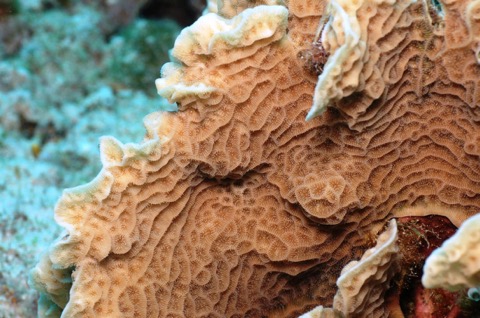
Also, doctoral student Meredith Meyers just (probably) landed her second publication in the last two months as she just got word from Journal of Heredity that only very minor revisions are necessary for her paper on fluorescent protein sequence evolution in the coral genus Agaricia. This is exciting not just because it is a publication, but this was the most technically punishing paper that she and I have had to work on and it touches on the boundaries of what we know as molecular evolution folk. When there are multiple copies of a gene in a group of organisms (and I suppose it is also possible that those species are hybridizing!), that means that the variation that is present in what we can survey represents allelic variation at a locus, the divergence of gene copies, and the divergence of gene copies in different species. Unfortunately, it is very difficult to tell where to draw the lines between these different ‘containers’ of diversity, but Meredith did a very good job examining the problem and I’ll post publication details when they are available.
Finally, long-time Wares Lab associate Jamie Winternitz (Altizer Lab, Odum School of Ecology) defends her dissertation today. Fantastic, difficult work on the interaction of immune system evolution and parasite load in montane voles. Looking forward to hoisting a beer in her honor later today.
You should be nervous for us. Please note the number of chickens I’ve counted before they’ve hatched in this post!

Also, doctoral student Meredith Meyers just (probably) landed her second publication in the last two months as she just got word from Journal of Heredity that only very minor revisions are necessary for her paper on fluorescent protein sequence evolution in the coral genus Agaricia. This is exciting not just because it is a publication, but this was the most technically punishing paper that she and I have had to work on and it touches on the boundaries of what we know as molecular evolution folk. When there are multiple copies of a gene in a group of organisms (and I suppose it is also possible that those species are hybridizing!), that means that the variation that is present in what we can survey represents allelic variation at a locus, the divergence of gene copies, and the divergence of gene copies in different species. Unfortunately, it is very difficult to tell where to draw the lines between these different ‘containers’ of diversity, but Meredith did a very good job examining the problem and I’ll post publication details when they are available.
Finally, long-time Wares Lab associate Jamie Winternitz (Altizer Lab, Odum School of Ecology) defends her dissertation today. Fantastic, difficult work on the interaction of immune system evolution and parasite load in montane voles. Looking forward to hoisting a beer in her honor later today.
You should be nervous for us. Please note the number of chickens I’ve counted before they’ve hatched in this post!
Squids and Japanese
15/10/12 11:51
I just have to give a shout-out to former Wares lab technician and all-around awesome young scientist Sabrina Pankey, because her website tells it all - in both English and Japanese (which she has learned in recent years).
Lab Art
09/10/12 15:02
We have been sprucing up the lab in the last month. I say “we”. I mean Christine and Katie, who have found an awesome sofa for one side to read in, have cleaned and organized the lab fantastically, and have helped me brainstorm about ways to improve the comfort and efficiency of our little research home. But I contributed a little bit. The last two months I’ve been somewhat sidelined by a back injury that left me not sleeping well, and not able to ride my bike until recently. So what does one do with this insomnia?
Well, sometimes, I weld. Behold: the branch length correct output from an ms simulation for 7 branches. Geeky, yes. But it represents the gene tree work, phylogenetic work, multiple phyla we work on, well. And it gave me the chance to melt metal late at night! This has been installed outside of the lab, so maybe visitors can find us just a little bit more easily in this bizarre building.
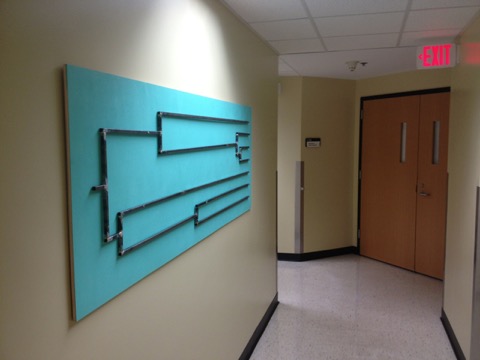
Well, sometimes, I weld. Behold: the branch length correct output from an ms simulation for 7 branches. Geeky, yes. But it represents the gene tree work, phylogenetic work, multiple phyla we work on, well. And it gave me the chance to melt metal late at night! This has been installed outside of the lab, so maybe visitors can find us just a little bit more easily in this bizarre building.

Altamaha
04/09/12 09:45
The latest issue of Nature Conservancy magazine has an excellent article on the magnificence of the Altamaha River here in Georgia. I’ve interacted with some of the dedicated folks mentioned in the article, and a number of other biologists through our lab’s work in the salt marshes at the mouth of this river and the freshwater mussels upstream, into the Ocmulgee, Ohoopee, and Oconee Rivers (the last one runs through Athens; they all have fantastic names). Especially in political seasons, Georgia can get a black eye for its somewhat-backward ways (evolution education and so on), but its a pretty place to live and this river is a gem of biodiversity that we’re pretty excited to be working on. Following up on Scott Small’s work on population biology and phylogeography of mussels in this river, current grad Katie Bockrath is snooping through the genome of Elliptio for genes that may be useful for exploring the high diversity of this genus in the southeast. Stay tuned!
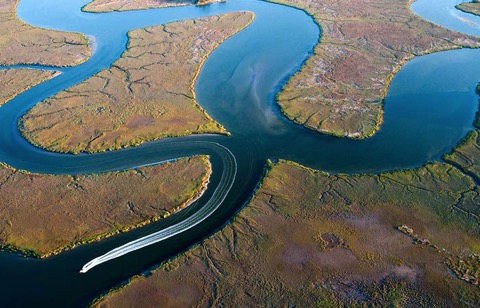

Wiki This
30/08/12 09:05
I’m always surprised that there are people who read this lab website blog. You really surely have better things to do with your time! But if you’re here, I’m going to point you to another website that you may find interesting. This semester I’m teaching Honors Evolution, a one-hour class each week that complements the big lecture class. The big class has 200 students, making personal interactions and discussions very difficult; the small class has 14, and I’m using it to experiment with how wikis can allow students to organize what they learn and even push the direction of a course to suit their interests.
Basically, the topic of the Honors course is how evolution intersects with climate change in marine populations. Will it ameliorate the effects of climate change by allowing populations to adapt to a shifting environment? Will only some species be able to adapt? Nobody really knows for sure, and there still hasn’t been much done on this topic in the literature. But my students’ job is to surf this literature and discuss it, synthesizing what they find on the wiki. This means that they work together, their grade is essentially based on participation and interaction, and at the end we might actually have an interesting, useful resource for learning more about evolution and climate change.
Anyway, this is all explained better on the site itself. It is a wiki, but only members of the class can contribute, so it is not an open community like Wikipedia. Nevertheless if you find it interesting there are places to comment, and I’m hoping this will be a fun thing to do this semester.
Basically, the topic of the Honors course is how evolution intersects with climate change in marine populations. Will it ameliorate the effects of climate change by allowing populations to adapt to a shifting environment? Will only some species be able to adapt? Nobody really knows for sure, and there still hasn’t been much done on this topic in the literature. But my students’ job is to surf this literature and discuss it, synthesizing what they find on the wiki. This means that they work together, their grade is essentially based on participation and interaction, and at the end we might actually have an interesting, useful resource for learning more about evolution and climate change.
Anyway, this is all explained better on the site itself. It is a wiki, but only members of the class can contribute, so it is not an open community like Wikipedia. Nevertheless if you find it interesting there are places to comment, and I’m hoping this will be a fun thing to do this semester.
Budget Freeze
10/08/12 11:54
On a trip to Legoland with my son, I got a call from a colleague that my ultracold (-80°) freezer was dying. A few quick iPhone moments and the damage was controlled, thanks to colleagues and students moving my samples to available freezers quickly. That left me with a very expensive freezer to fix, but no lost stuff (I hope).
As it turns out, the University fired the few physical plant employees who were certified to work on these freezers last year. To save the school money, of course. Now, I pay the same 48.5% in overhead on my grants as always, but when my freezer dies the university doesn’t have my back anymore. A private contractor had to be called in, and long story short this will cost one of my grants nearly $6000. (Suggesting there is about $3000 in overhead that is covering the 10 burned-out 100W incandescent bulbs in the ceiling of my lecture hall? Or maybe that money could be used to repair the swimming pool on campus?).
Well, okay, I get it. State schools are strapped for money. Research costs money, and thankfully I have some NSF funds that will cover this so we can get back to work. But the math here doesn’t add up well.
In the meantime, my remaining freezers are packed to the gills and of course much of that needs to be re-organized, but we are also now at about the 8-year mark of my lab being open, and that means there is likely to be some stuff in there that just doesn’t need to be:

That’s one full 50-gallon trashcan just from one of the -20 freezers. There are some things that are hard to let go of, but need to be. For example, the box on top labeled ‘Tectura testudinalis’ are all of the samples (only about 35) that I collected of this limpet for my dissertation. But the sample is small enough that there is simply nothing useful to be done with them, beyond the freebie paper (see “Baby It’s Cold Outside”) I published on this blog last year!
Former and current students and postdocs: I assure you I’ve thrown nothing away that was properly labeled or appeared to be from the past, say, 4 years. But frostbitten 96-well plates with no labeling: gone!
As it turns out, the University fired the few physical plant employees who were certified to work on these freezers last year. To save the school money, of course. Now, I pay the same 48.5% in overhead on my grants as always, but when my freezer dies the university doesn’t have my back anymore. A private contractor had to be called in, and long story short this will cost one of my grants nearly $6000. (Suggesting there is about $3000 in overhead that is covering the 10 burned-out 100W incandescent bulbs in the ceiling of my lecture hall? Or maybe that money could be used to repair the swimming pool on campus?).
Well, okay, I get it. State schools are strapped for money. Research costs money, and thankfully I have some NSF funds that will cover this so we can get back to work. But the math here doesn’t add up well.
In the meantime, my remaining freezers are packed to the gills and of course much of that needs to be re-organized, but we are also now at about the 8-year mark of my lab being open, and that means there is likely to be some stuff in there that just doesn’t need to be:

That’s one full 50-gallon trashcan just from one of the -20 freezers. There are some things that are hard to let go of, but need to be. For example, the box on top labeled ‘Tectura testudinalis’ are all of the samples (only about 35) that I collected of this limpet for my dissertation. But the sample is small enough that there is simply nothing useful to be done with them, beyond the freebie paper (see “Baby It’s Cold Outside”) I published on this blog last year!
Former and current students and postdocs: I assure you I’ve thrown nothing away that was properly labeled or appeared to be from the past, say, 4 years. But frostbitten 96-well plates with no labeling: gone!
Graduate Education
18/06/12 16:12
Are you interested in the study of evolutionary biology? Are you excited about the promise that new genomic tools offer for identifying the factors that promote and maintain biological diversity around the planet? Do you envision solving great problems as a scientist?
Good. Now put down the pipettor, and start learning to program. More and more, the work being done in labs like mine (and many of the evolution labs here in the Department of Genetics) involves data sets that are orders of magnitude larger than anything available when I got my Ph.D. Not only could you collect all of the data from my dissertation in one day of a well-organized sequencing effort, you would have to fill up the array with dozens of other dissertations as well to make it cost-efficient.... at a total cost of only a few thousand dollars.
All of that data means that it isn’t enough to have an interesting idea. You have to be able to manipulate large amounts of data, whether you are doing genomics or ecology or developmental biology, and this means you (prospective graduate student) need to become very familiar with languages or programming environments like R, python, perl. Twenty years ago you might be asked to be proficient in German or Spanish to get a Ph.D. Now it would be one of these languages, certainly. We spend more time in front of computers, and less time in the lab (fortunately, for a lab like mine, the amount of field work is about the same, though never as much as I’d like!).
Many fields are being transformed by computational approaches, and that is not a bad thing. It simply means more data. This is true in linguistics and literature as well as the sciences. So as you start to write your essays about what attracts you to our graduate program (I’m graduate coordinator, I expect to read about 40 of these essays in late December....), think hard about the ways you can learn to work with data quickly and efficiently. Make the data work for you, not the other way around. I say this from the rough experience of juggling a number of large data sets, each with their own quirks - now if only I could write a script that could write the papers for me as well....

Good. Now put down the pipettor, and start learning to program. More and more, the work being done in labs like mine (and many of the evolution labs here in the Department of Genetics) involves data sets that are orders of magnitude larger than anything available when I got my Ph.D. Not only could you collect all of the data from my dissertation in one day of a well-organized sequencing effort, you would have to fill up the array with dozens of other dissertations as well to make it cost-efficient.... at a total cost of only a few thousand dollars.
All of that data means that it isn’t enough to have an interesting idea. You have to be able to manipulate large amounts of data, whether you are doing genomics or ecology or developmental biology, and this means you (prospective graduate student) need to become very familiar with languages or programming environments like R, python, perl. Twenty years ago you might be asked to be proficient in German or Spanish to get a Ph.D. Now it would be one of these languages, certainly. We spend more time in front of computers, and less time in the lab (fortunately, for a lab like mine, the amount of field work is about the same, though never as much as I’d like!).
Many fields are being transformed by computational approaches, and that is not a bad thing. It simply means more data. This is true in linguistics and literature as well as the sciences. So as you start to write your essays about what attracts you to our graduate program (I’m graduate coordinator, I expect to read about 40 of these essays in late December....), think hard about the ways you can learn to work with data quickly and efficiently. Make the data work for you, not the other way around. I say this from the rough experience of juggling a number of large data sets, each with their own quirks - now if only I could write a script that could write the papers for me as well....

Horseshoes
04/06/12 10:55
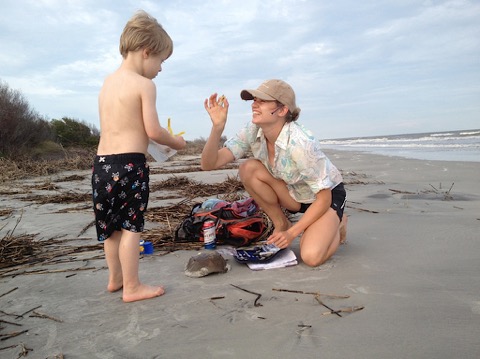
Another brilliant (but too short) trip to Sapelo. Christine Ewers is on another run of collecting horseshoe crabs for the Chelonibia (n.b. - as of June 2012, no page exists for this genus yet at Wikipedia, and barely noted in the Encyclopedia of Life) barnacles that grow on their backs. Horseshoe crabs come up to the beach at the highest tides to mate, so we were able to collect a few near sunset each day for her samples. Riley Wares helped out with the whirl-paks and enthusiasm!
For those of you who haven’t been to or worked at Sapelo Island, this is where UGA hosts its marine lab: certainly one of the more unusual marine labs I’ve been to. It has minimal infrastructure, but also minimal nearby development. Staff and researchers are housed in the buildings around R.J. Reynold’s old mansion, and we are well located for beach and salt marsh work (and play!). The island is separated from the coast by a 20-minute Department of Natural Resources ferry ride, a bargain at $1 per passenger.
Black Gloves
16/04/12 13:55
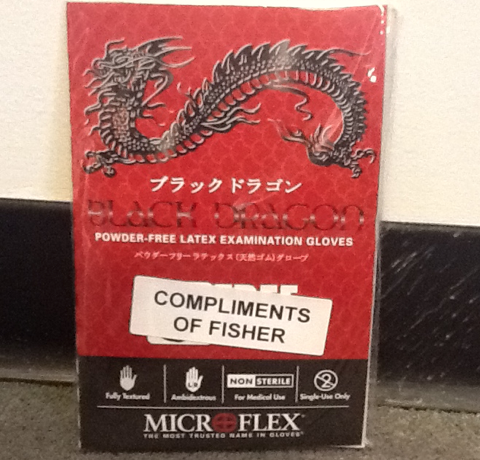
Dear Fisher Scientific, is this really necessary marketing of lab gloves? First of all, I don’t care what color they are. Black gloves, sure, add a little panache to my work dissecting freshwater mussels for an upcoming genome project. But I don’t care if they are blue, purple, natural, or studded for lab work pleasure (sorry, this packaging is just too ridiculous). But thanks for the free samples anyway. I would prefer, actually, that you made gloves that were more easily re-used, e.g. have a little tiny tab on each finger for easy right-side-out removal. It isn’t the cost of gloves, just seems silly to toss gloves that have handled the innocuous things we handle in my lab, as long as there aren’t cross-project contamination issues. Anyway, this free pair of black gloves is waiting outside of my office for when the DNA isolation is done later today, I got them off for at least one re-use. I might use them the next time I need to dress up like a ninja or spy, too.
So far, a good year in the lab - three papers published, and several in review/in revision. Not that it matters for raises (there are none in the University of Georgia system), promotion (I’m a long way from ever moving up again), or fame (I’m happily infamous), it just means those projects are gone from my desk.
Ewers, C. and J. P. Wares. 2012. Examining an outlier: molecular diversity in the Cirripedia. Integrative & Comparative Biology. In Press.
Small, S. T., R. Eytan, K. Bockrath, J. P. Wares. 2012. Evaluation of genetic structure across freshwater mussel community (genus Elliptio) in the Altamaha River basin. Conservation Genetics, in press.
Zakas, C., N. Schult, D. McHugh, K. Jones, J. P. Wares. 2012. Transcriptome analysis and SNP development can resolve population differentiation of Streblospio benedicti, a developmentally dimorphic marine annelid. PLoS ONE, 7(2): e31613.
Public
14/03/12 10:21
I’m always surprised to find that anybody reads this! I got an email about a week ago, though, from a rep at Affymetrix. Presumably they search websites for mention of the Exo-SAP protocol that one of their subsidiaries developed, and which is now sold as a kit under the Exo-SAP-it product line. It is appropriate to note, since this is on the web, that the technique is theirs and should have a little ® after it. We don’t actually use their kit - we buy the ExoI and Antarctic phosphatase from NEB, though I’d be happy to try their product in the future if it gains us a little time or success rate in our work. We are actually still having some hiccups with Sanger sequencing, issues that started about a year ago - some projects sequence beautifully, but most of our mitochondrial work is sequencing poorly unless (and sometimes even when) taxon-specific primers are developed. Another reason to start heading toward nex-gen sequencing solutions!
Time is On My Side
05/03/12 11:29
I was just getting excited about the fact that I’ve finished lecturing for the semester, finished hosting a student from another institution, finished giving my talk at Auburn, finished with graduate recruitment activities - now I can start catching up - and this morning, this very morning, I get two manuscripts in my inbox for revision. The good news, they both look like they’ll be accepted with a bit of work.
One of the things that needs to be done to make one paper acceptable, the paper on freshwater mussels, is to make sure that people can access Scott Small’s report to Georgia Department of Natural Resources which was given to them in May 2009. I know how it goes with these reports: they can be a bear to get a copy of. So, I’m posting his report here.
Overall, I see it is time to update this site a bit too, so maybe some new references and links will go up soon... but not today!
One of the things that needs to be done to make one paper acceptable, the paper on freshwater mussels, is to make sure that people can access Scott Small’s report to Georgia Department of Natural Resources which was given to them in May 2009. I know how it goes with these reports: they can be a bear to get a copy of. So, I’m posting his report here.
Overall, I see it is time to update this site a bit too, so maybe some new references and links will go up soon... but not today!
Phylogeography
20/01/12 12:29
Almost a year ago, I wrote this short article for the Nature Education series (Scitable)... they decided it was written at a more advanced level than they wanted, and I don’t feel like rewriting it, but some of the sporadic readers here may find it a useful piece on where the field of phylogeography has been and where it is going.
scit_phylo_jpw
scit_phylo_jpw
New Year
17/01/12 12:08
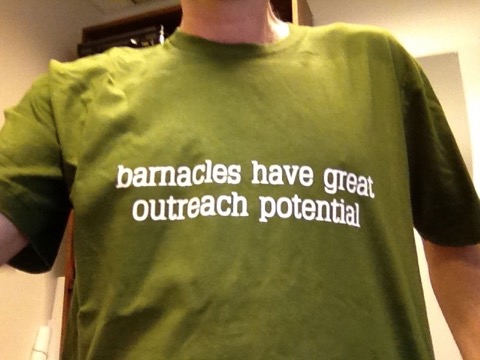
To add to the pantheon of great Nerd Shirts out there, we made these T-shirts for the SICB meeting in Charleston, SC which I attended the first weekend of January, along with Christina Zakas and Christine Ewers from my lab. Presumably, this was only funny to the 12 or so members of the symposium I spoke at, but if you understand this: you are also a nerd.
As always, much going on. The RAD-tagged data are back for Notochthamalus, and Christina is working on interpreting these data (hopefully before I give a talk on this project in early March at Auburn!). We also now have specimens of Notochthamalus from Ushuaia, the southernmost city on the planet - no matter what answer their DNA barcodes give up, it will be an interesting one.
We are also pleased to be hosting César Ribeiro, from the Universidade de Aveiro in Portugal. He is a doctoral student with a background in biochemistry and physical modeling, working on the physical oceanography of the Macaronesian Islands and how the oceanography mates with population genetic data. This is not an easy problem, and very similar to what we are trying to do on the east coast of the US and the coast of Chile.